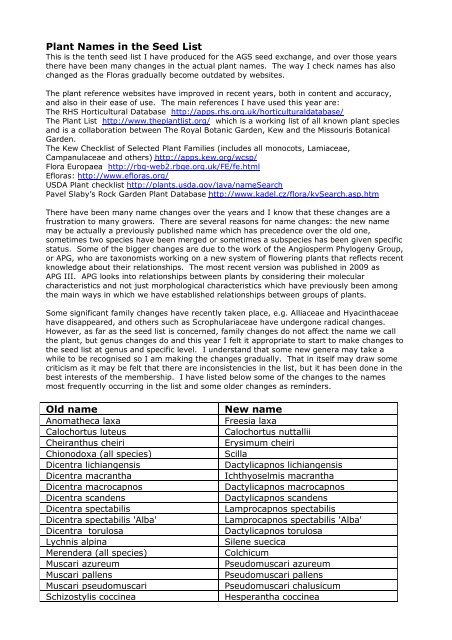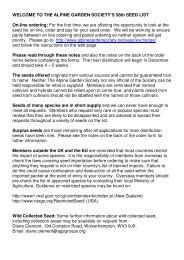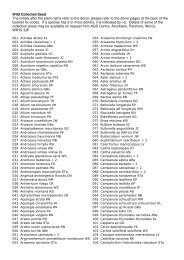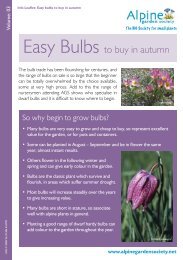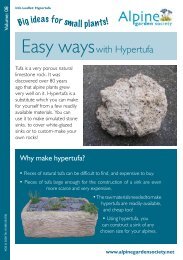AGS Seed List No 60 2011 - Alpine Garden Society
AGS Seed List No 60 2011 - Alpine Garden Society
AGS Seed List No 60 2011 - Alpine Garden Society
You also want an ePaper? Increase the reach of your titles
YUMPU automatically turns print PDFs into web optimized ePapers that Google loves.
Plant Names in the <strong>Seed</strong> <strong>List</strong><br />
This is the tenth seed list I have produced for the <strong>AGS</strong> seed exchange, and over those years<br />
there have been many changes in the actual plant names. The way I check names has also<br />
changed as the Floras gradually become outdated by websites.<br />
The plant reference websites have improved in recent years, both in content and accuracy,<br />
and also in their ease of use. The main references I have used this year are:<br />
The RHS Horticultural Database http://apps.rhs.org.uk/horticulturaldatabase/<br />
The Plant <strong>List</strong> http://www.theplantlist.org/ which is a working list of all known plant species<br />
and is a collaboration between The Royal Botanic <strong>Garden</strong>, Kew and the Missouris Botanical<br />
<strong>Garden</strong>.<br />
The Kew Checklist of Selected Plant Families (includes all monocots, Lamiaceae,<br />
Campanulaceae and others) http://apps.kew.org/wcsp/<br />
Flora Europaea http://rbg-web2.rbge.org.uk/FE/fe.html<br />
Efloras: http://www.efloras.org/<br />
USDA Plant checklist http://plants.usda.gov/java/nameSearch<br />
Pavel Slaby’s Rock <strong>Garden</strong> Plant Database http://www.kadel.cz/flora/kvSearch.asp.htm<br />
There have been many name changes over the years and I know that these changes are a<br />
frustration to many growers. There are several reasons for name changes: the new name<br />
may be actually a previously published name which has precedence over the old one,<br />
sometimes two species have been merged or sometimes a subspecies has been given specific<br />
status. Some of the bigger changes are due to the work of the Angiosperm Phylogeny Group,<br />
or APG, who are taxonomists working on a new system of flowering plants that reflects recent<br />
knowledge about their relationships. The most recent version was published in 2009 as<br />
APG III. APG looks into relationships between plants by considering their molecular<br />
characteristics and not just morphological characteristics which have previously been among<br />
the main ways in which we have established relationships between groups of plants.<br />
Some significant family changes have recently taken place, e.g. Alliaceae and Hyacinthaceae<br />
have disappeared, and others such as Scrophulariaceae have undergone radical changes.<br />
However, as far as the seed list is concerned, family changes do not affect the name we call<br />
the plant, but genus changes do and this year I felt it appropriate to start to make changes to<br />
the seed list at genus and specific level. I understand that some new genera may take a<br />
while to be recognised so I am making the changes gradually. That in itself may draw some<br />
criticism as it may be felt that there are inconsistencies in the list, but it has been done in the<br />
best interests of the membership. I have listed below some of the changes to the names<br />
most frequently occurring in the list and some older changes as reminders.<br />
Old name New name<br />
Anomatheca laxa Freesia laxa<br />
Calochortus luteus Calochortus nuttallii<br />
Cheiranthus cheiri Erysimum cheiri<br />
Chionodoxa (all species) Scilla<br />
Dicentra lichiangensis Dactylicapnos lichiangensis<br />
Dicentra macrantha Ichthyoselmis macrantha<br />
Dicentra macrocapnos Dactylicapnos macrocapnos<br />
Dicentra scandens Dactylicapnos scandens<br />
Dicentra spectabilis Lamprocapnos spectabilis<br />
Dicentra spectabilis 'Alba' Lamprocapnos spectabilis 'Alba'<br />
Dicentra torulosa Dactylicapnos torulosa<br />
Lychnis alpina Silene suecica<br />
Merendera (all species) Colchicum<br />
Muscari azureum Pseudomuscari azureum<br />
Muscari pallens Pseudomuscari pallens<br />
Muscari pseudomuscari Pseudomuscari chalusicum<br />
Schizostylis coccinea Hesperantha coccinea


